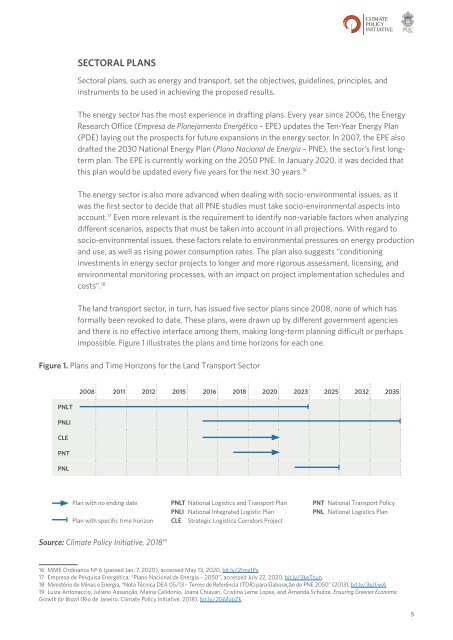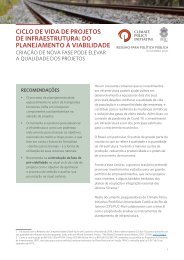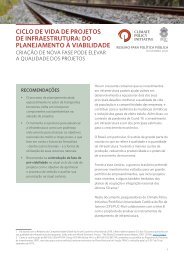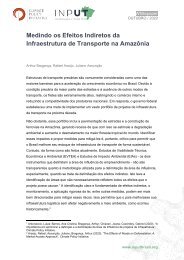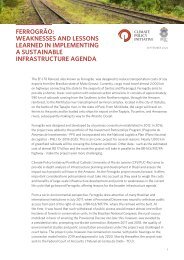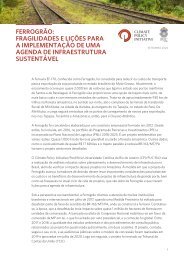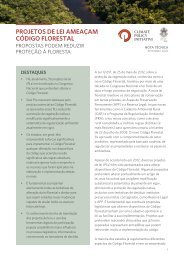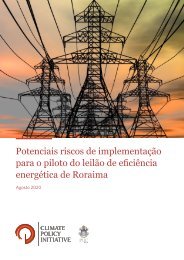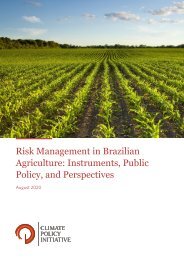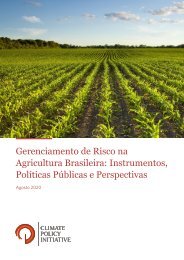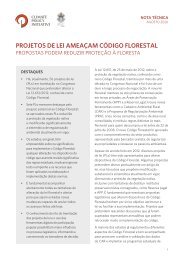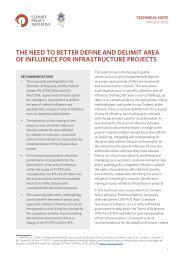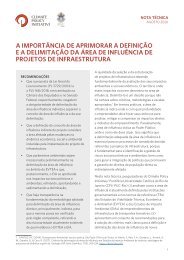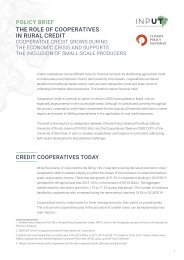BOX 1. INFRASTRUCTURE DEVELOPMENT IN THE AMAZON The EFD sets “reducing illegal deforestation” as a challenge <strong>to</strong> be overcome by the Brazilian government, but it makes no explicit mention <strong>of</strong> the Amazon. Domestic and foreign inves<strong>to</strong>rs, however, understand the importance <strong>of</strong> the region and the ecosystem services it provides, and they have taken public stances vis-à-vis investment prospects in the region and in the country. 5,6,7 Over recent years, a growing international movement has sought <strong>to</strong> define a development pathway with a socio-environmental focus. In 2019, the G-20 General Assembly approved voluntary recommendations for quality infrastructure with reference <strong>to</strong> socio-environmental principles, 8 and in January 2020 the World Economic Forum recognized sustainability as its core element. 9 Generally speaking, in 2020 the sustainability imperative in the social and environmental sphere has become part <strong>of</strong> the mainstream for businesses, inves<strong>to</strong>rs, political and economic leaders, and, more importantly, for new generations.The Amazon features prominently in global commitments and concerns. For Brazil, which is home <strong>to</strong> approximately 60% <strong>of</strong> the Amazon basin and has seen its deforestation rates grow, 10 the Amazon is a major focus <strong>of</strong> policies for preserving the region <strong>from</strong> a socio-environmental standpoint. Therefore, controlling deforestation is not just crucial, it is also an objective <strong>to</strong> be achieved under the country’s international climate commitments 11 and its National Climate Change Policy 12 . <strong>Infrastructure</strong> services that provide water, sanitation, health, mobility, and electricity at the local level are essential for the people who inhabit the Amazon. The existence <strong>of</strong> local infrastructure also encourages farmers <strong>to</strong> adopt intensive land use practices by lowering transportation costs for inputs and products, and by providing access <strong>to</strong> technical assistance and electricity for potential processing operations, in addition <strong>to</strong> fostering a bioeconomy. As is well known, however, large infrastructure projects were one <strong>of</strong> the biggest drivers <strong>of</strong> deforestation in the Amazon in the past. Over 80% <strong>of</strong> forest conversions occurred along roads. 13,14 In addition, the road, energy, and mining sec<strong>to</strong>rs located in the Amazon basin, <strong>to</strong>gether, threaten more than 50% <strong>of</strong> all protected areas, including Conservation Units and Indigenous Lands. 15 This is, therefore, an opportunity <strong>to</strong> reflect upon a development strategy for the country, with infrastructure as a powerful instrument <strong>to</strong> achieve national goals, while considering the future <strong>of</strong> the Amazon and the way its natural resources are used. 5 Gabriel Shinohara, “Em Carta, Ex-Ministros e Ex-Presidentes Do BC Cobram Desmatamen<strong>to</strong> Zero Na Amazônia e No Cerrado” (O Globo, July 14, 2020), accessed July 14, 2020, glo.bo/3kl7mvf. 6 Célia Froufe, “Investidores Ameaçam Sair Do Brasil Se Destruição Da Amazônia Não Parar, Diz Financial Times” (O Estado de São Paulo, June 23, 2020), accessed July 14, 2020, bit.ly/3prvrEz. 7 Assessoria Cebds, “Se<strong>to</strong>r Empresarial Cobra Agenda Sustentável Do Governo Brasileiro” (Conselho Empresarial Brasileiro Para o Desenvolvimen<strong>to</strong> Sustentável, July 7, 2020), accessed July 14, 2020, bit.ly/2UeDSEC. 8 Ministry <strong>of</strong> Finance <strong>of</strong> Japan, “G20 Principles for <strong>Quality</strong> <strong>Infrastructure</strong> Investment” (2019), accessed July 14, 2020, bit.ly/3ePrkNC. 9 Marsh & McLennan, “Global Risks Report 2020” (Davos: World Economic Forum, 2020), accessed July 14, 2020, bit.ly/2Il6Fos. 10 National Institute for Space Research, “The Estimate <strong>of</strong> the Rate <strong>of</strong> Clear-Cut Deforestation for the Legal Amazon in 2019 is 9,762 km²”, (2019), accessed July 14, 2020, bit.ly/36lBhhW. 11 Ministério do Meio Ambiente, “Contribuição Nacionalmente Determinada”, accessed July 14, 2020, bit.ly/3kfB3O0. 12 Federal Law Nº 12,187 (December 29, 2009), accessed July 14, 2020, bit.ly/3eJ4GWY. 13 Sadia Ahmed, Carlos Souza, Julia Ribeiro, and Robert Ewers, “Temporal patterns <strong>of</strong> road network development in the Brazilian Amazon” (Regional Environmental Change, 2013, 13(5), 927-937), accessed July 14, 2020, bit.ly/36mhBua. 14 Chris<strong>to</strong>pher Barber, Mark Cochrane, Carlos Souza, and William Laurance, “Roads, Deforestation, and the Mitigating Effect <strong>of</strong> Protected Areas in the Amazon” (Biological Conservation, 2014, 177(1) 203–209), accessed July 14, 2020, bit.ly/2IkyY6i. 15 Amazon Network <strong>of</strong> Georeferenced Social and Environmental Information – RAISG, “Amazonía Bajo Presión” (2012, p.60), bit.ly/3eIKWml. 4
SECTORAL PLANS Sec<strong>to</strong>ral plans, such as energy and transport, set the objectives, guidelines, principles, and instruments <strong>to</strong> be used in achieving the proposed results. The energy sec<strong>to</strong>r has the most experience in drafting plans. Every year since 2006, the Energy Research Office (Empresa de Planejamen<strong>to</strong> Energético – EPE) updates the Ten-Year Energy Plan (PDE) laying out the prospects for future expansions in the energy sec<strong>to</strong>r. In 2007, the EPE also drafted the 2030 National Energy Plan (Plano Nacional de Energia – PNE), the sec<strong>to</strong>r’s first longterm plan. The EPE is currently working on the 2050 PNE. In January 2020, it was decided that this plan would be updated every five years for the next 30 years. 16 The energy sec<strong>to</strong>r is also more advanced when dealing with socio-environmental issues, as it was the first sec<strong>to</strong>r <strong>to</strong> decide that all PNE studies must take socio-environmental aspects in<strong>to</strong> account. 17 Even more relevant is the requirement <strong>to</strong> identify non-variable fac<strong>to</strong>rs when analyzing different scenarios, aspects that must be taken in<strong>to</strong> account in all projections. With regard <strong>to</strong> socio-environmental issues, these fac<strong>to</strong>rs relate <strong>to</strong> environmental pressures on energy production and use, as well as rising power consumption rates. The plan also suggests “conditioning investments in energy sec<strong>to</strong>r projects <strong>to</strong> longer and more rigorous assessment, licensing, and environmental moni<strong>to</strong>ring processes, with an impact on project implementation schedules and costs”. 18 The land transport sec<strong>to</strong>r, in turn, has issued five sec<strong>to</strong>r plans since 2008, none <strong>of</strong> which has formally been revoked <strong>to</strong> date. These plans, were drawn up by different government agencies and there is no effective interface among them, making long-term planning difficult or perhaps impossible. Figure 1 illustrates the plans and time horizons for each one. Figure 1. Plans and Time Horizons for the Land Transport Sec<strong>to</strong>r Source: Climate Policy Initiative, 2018 19 16 MME Ordinance Nº 6 (passed Jan. 7, 2020), accessed <strong>May</strong> 13, 2020, bit.ly/2Imz1Ps. 17 Empresa de Pesquisa Energética, “Plano Nacional de Energia – 2050”, accessed July 22, 2020, bit.ly/3keTsun. 18 Ministério de Minas e Energia, “Nota Técnica DEA 05/13 – Termo de Referência (TDR) para Elaboração do PNE 2050” (2013), bit.ly/3eJIiwA. 19 Luiza An<strong>to</strong>naccio, Juliano Assunção, Maína Celidonio, Joana Chiavari, Cristina Leme Lopes, and Amanda Schutze, Ensuring Greener Economic Growth for Brazil (Rio de Janeiro: Climate Policy Initiative, 2018), bit.ly/2GMopZk. 5


